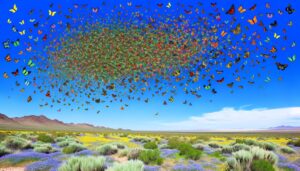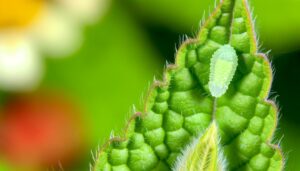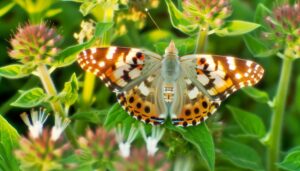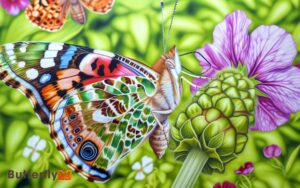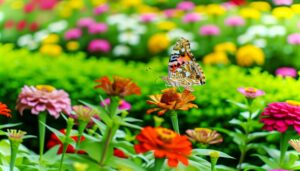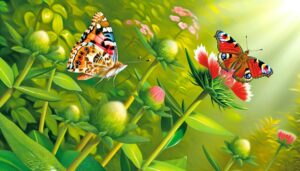Painted Lady Butterfly Emerging From Chrysalis: Explained!
When a Painted Lady butterfly emerges from its chrysalis, it undergoes a marvel of biological transformation. Inside the chrysalis, larval tissues are broken down by enzymes, allowing imaginal discs to form adult structures like wings, legs, and antennae.
The process is regulated by ecdysone hormones. As the butterfly prepares to emerge, the chrysalis darkens and becomes transparent. The butterfly pushes against the chrysalis walls, using thorax muscles to break free.
Hemolymph pumps into the wings for expansion, which then dry and harden, preparing for the first flight. Observing this transformation reveals the intricate stages of metamorphosis.
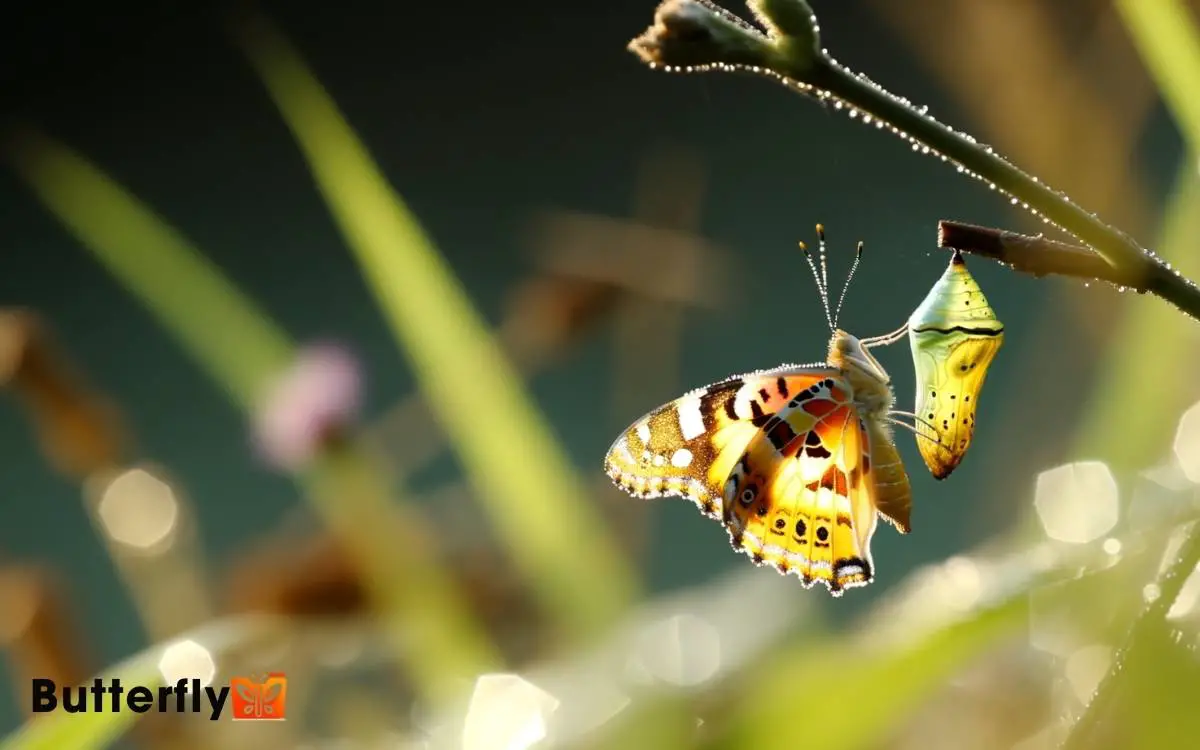
Key Takeaways
Life Cycle Overview
The life cycle of the Painted Lady butterfly, scientifically known as Vanessa cardui, comprises four distinct stages: egg, larva (caterpillar), pupa (chrysalis), and adult butterfly.
The cycle begins when the female lays eggs on host plants. These tiny, green eggs hatch in about 3-5 days, releasing larvae. After feeding voraciously, the larvae undergo several molts.
Following this period, they enter the pupal stage, forming a chrysalis. Inside the chrysalis, profound metamorphosis occurs over approximately 7-10 days. During this time, the larval structures break down, and adult features develop.
Caterpillar Stage
During the caterpillar stage, the Painted Lady larva prioritizes consuming vast amounts of host plant leaves to fuel rapid growth.
This phase involves a series of molting events, known as instars, where the caterpillar sheds its exoskeleton to accommodate its increasing size.
Each instar marks a critical point in its development, enabling the caterpillar to progress toward eventual pupation.
Eating and Growing Phases
A Painted Lady butterfly caterpillar spends its days voraciously consuming host plants to fuel its rapid growth and development. It primarily feeds on leaves, stems, and buds, focusing on nutrient-rich parts to maximize energy intake.
During this stage, the caterpillar exhibits rapid weight gain and size increase as it prepares for metamorphosis.
The caterpillar’s diet is crucial for several reasons:
- Energy for Growth: Enables significant size increase.
- Nutrient Storage: Builds reserves for future stages.
- Defensive Chemicals: Acquires toxins from certain plants for protection.
- Tissue Development: Supports formation of essential organs.
- Molting Preparation: Prepares for shedding old skin.
This intense feeding phase is necessary for the caterpillar to progress successfully to the next life stage.
Molting and Instars
Caterpillars undergo a series of molts, shedding their exoskeletons to accommodate rapid growth and progressing through multiple instars. Each instar represents a distinct developmental stage where the caterpillar’s size and morphology change greatly.
Painted Lady caterpillars typically pass through five instars. During each molt, enzymes break down the old exoskeleton, allowing the caterpillar to wriggle free and expand its body before the new exoskeleton hardens.
This process is vital, as it enables the caterpillar to grow larger and more robust, preparing it for the eventual shift to the pupal stage.
The intervals between molts are marked by periods of intense feeding, where the caterpillar consumes large amounts of host plant material to fuel its rapid growth and development.
Forming the Chrysalis
Often, the larva undergoes a remarkable transformation as it forms the chrysalis, meticulously spinning silk to anchor itself securely. This process is a critical phase in the lifecycle of the Painted Lady butterfly. During this stage, the Painted Lady butterfly larvae shed their final exoskeleton, revealing the chrysalis beneath. Inside the protective casing, the caterpillar’s body undergoes a complex metamorphosis, gradually transforming into an adult butterfly. After several days, the chrysalis darkens, signaling that the butterfly is nearly ready to emerge.
The larva first attaches itself to a safe surface, typically a leaf or stem, using its silk pad. Then, it sheds its final larval skin, revealing the soft chrysalis beneath. This chrysalis hardens, providing protection during metamorphosis.
Key steps in forming the chrysalis:
- Silk attachment: The larva spins a silk pad to hold itself in place.
- Hanging position: It assumes a J-shape, hanging upside down.
- Larval skin shedding: The last larval skin is cast off.
- Chrysalis hardening: The new chrysalis structure solidifies.
- Securing itself: Ensures it’s firmly attached to avoid predators.
Inside the Chrysalis
Within the chrysalis, the Painted Lady butterfly undergoes a complex and astonishing metamorphosis, with its tissues and organs breaking down and reforming into the structures of an adult butterfly.
This process, known as histolysis, involves the dissolution of larval tissues by enzymes.
Simultaneously, histogenesis occurs, where clusters of rapidly dividing cells, called imaginal discs, develop into adult structures like wings, legs, and antennae.
Nutrients from the broken-down larval body fuel this growth. Hormones, particularly ecdysone, regulate these changes, ensuring precise timing and coordination.
The transformation is energy-intensive, requiring careful metabolic management within the chrysalis. Throughout this period, the chrysalis appears still, but inside, a flurry of biochemical activity is orchestrating the butterfly’s remarkable development.
Transformation Process
The transformation process of the Painted Lady butterfly encompasses distinct stages of metamorphosis, each marked by significant biological changes.
During this period, the larval tissues undergo histolysis while imaginal cells proliferate to form adult structures.
This intricate sequence results in the emergence of a fully developed butterfly from the chrysalis.
Metamorphosis Stages Explained
Metamorphosis in the Painted Lady butterfly, frequently observed in controlled environments, encompasses four distinct stages: egg, larva, pupa, and adult. Each stage is critical and follows a precise sequence.
Initially, the female lays eggs on host plants. These eggs hatch into larvae, also known as caterpillars, which voraciously consume leaves to grow.
Following significant growth, the larva forms a chrysalis, entering the pupal stage. Within this protective casing, it undergoes remarkable transformation, reorganizing its structure entirely.
Biological Changes Overview
As the larva enters the pupal stage, intricate cellular processes commence, leading to the butterfly’s complete anatomical restructuring.
Imaginal discs, clusters of specialized cells, activate and proliferate, forming essential adult structures such as wings, legs, and antennae.
Concurrently, larval tissues undergo apoptosis, a programmed cell death, to make room for the emerging adult morphology. Hormones, particularly ecdysone, regulate these transformations, ensuring precise timing and coordination.
Nutrients stored during the larval stage fuel the rapid and energy-intensive development. The chrysalis hardens, providing protection while enzymes break down and recycle larval proteins.
This remarkable transformation exemplifies nature’s ingenuity, turning a caterpillar into a strikingly beautiful butterfly, ready to start on its life of pollination and reproduction.
Signs of Emergence
One clear sign of the Painted Lady butterfly’s imminent emergence is the chrysalis turning darker as the adult butterfly’s colors become visible through its casing.
This color transformation indicates that the metamorphosis is nearly complete and the butterfly is ready to emerge.
Observers should look for several key indicators:
- The chrysalis becomes more transparent, showing the butterfly’s wings.
- Movement within the chrysalis as the butterfly shifts to prepare for emergence.
- The presence of small cracks on the chrysalis surface.
- A decrease in the chrysalis’ overall opacity.
- The chrysalis may exhibit slight tremors.
These signs are essential for understanding the final stages of the Painted Lady’s transformation, signaling that emergence is imminent.
Breaking Free
The Painted Lady butterfly uses its legs and wings to push against the walls of the chrysalis, creating the initial break that will lead to its emergence. This process, known as eclosion, is a critical phase in its life cycle.
The butterfly exerts pressure, causing the chrysalis to crack and split. It continues to wriggle and push, gradually widening the opening.
The thorax muscles contract and expand, aiding in the breakout effort. This struggle is essential for strengthening the butterfly’s muscles and ensuring it’s ready for life outside.
As the chrysalis gives way, the butterfly begins to pull itself free, first its head, followed by its body. Each movement is deliberate, ensuring a successful emergence.
Wing Expansion
Upon emerging from the chrysalis, the Painted Lady butterfly immediately begins pumping hemolymph into its crumpled wings to expand and harden them. This process is crucial for the butterfly’s ability to fly.
Hemolymph, the insect equivalent of blood, flows through the veins and unfolds the wings. Over the next few hours, the wings will dry and stiffen, reaching their full functionality.
Key aspects of this process include:
- Hemolymph pumping: Vital for wing expansion.
- Vein structure: Channels hemolymph efficiently.
- Wing drying: Essential for rigidity.
- Time requirement: Takes a few hours.
- Environmental factors: Temperature and humidity can impact drying.
This meticulous process guarantees the Painted Lady’s wings are fully prepared for flight. Understanding each step highlights the complexity of this transformation.
First Flight
As the Painted Lady butterfly’s wings unfold gracefully, it prepares for its inaugural flight. With each wingbeat, it navigates new heights, testing its strength and agility in the air. This first flight is vital for survival, as it seeks out food sources and establishes its territory.
Wings Unfolding Gracefully
With meticulous precision, the Painted Lady butterfly extends its wings, allowing hemolymph to pump through the veins, guaranteeing their full, vibrant expanse. This process, known as eclosion, is crucial for the butterfly’s survival.
The wings, initially crumpled, straighten and harden, transforming into delicate yet functional structures. Hemolymph circulation guarantees the wings reach their intended size and shape.
Key aspects of wing unfolding:
- Hemolymph Flow: Essential for expanding and hardening wings.
- Wing Veins: Act as conduits for hemolymph, providing structural integrity.
- Evaporation: Helps dry and stiffen the wings post-expansion.
- Pigmentation: Develops fully, showcasing vivid patterns.
- Wing Scales: Form a protective, colorful layer aiding in flight and camouflage.
This intricate process prepares the butterfly for its imminent first flight.
Navigating New Heights
Taking to the air for the first time, the Painted Lady butterfly demonstrates a remarkable blend of instinct and adaptation.
This initial flight is vital for survival, involving complex motor skills and sensory inputs. As the butterfly flaps its newly unfurled wings, it navigates wind currents, using its compound eyes to detect light patterns and its antennae to sense chemical cues.
These sensory inputs guide it towards nectar sources and away from potential threats.
The successful execution of this flight demands precise coordination between the nervous system and muscular responses. Each wingbeat strengthens the butterfly’s flight muscles, enhancing its ability to escape predators and find food.
The Painted Lady’s first flight marks a pivotal step in its life cycle, ensuring its continued survival and reproduction.
Importance to Ecosystem
Integral to pollination and serving as a food source for various predators, the Painted Lady butterfly plays an essential role in maintaining the balance of its ecosystem.
This species contributes to floral health and biodiversity through its migratory patterns and feeding behaviors.
Specifically, the Painted Lady:
- Pollinates a diverse range of flowering plants, aiding in plant reproduction.
- Serves as prey for birds, spiders, and other insects, thereby supporting higher trophic levels.
- Contributes to nutrient cycling by decomposing plant matter during its larval stage.
- Aids in genetic diversity by cross-pollinating plants across vast geographic regions.
- Indicates environmental health, acting as a bioindicator for ecosystem changes.
Understanding these roles highlights the butterfly’s ecological importance and the need for its conservation.
Conclusion
In the blink of an eye, the painted lady butterfly emerges from its chrysalis, beginning a new chapter. This metamorphosis, a marvel of nature, underscores the delicate balance and beauty of life cycles.
As it spreads its wings for the first time, the butterfly isn’t just taking flight; it’s entering into an intricate web of ecological relationships.
This transformation illustrates nature’s remarkable ability to adapt and flourish, even in the face of life’s inevitable changes.

